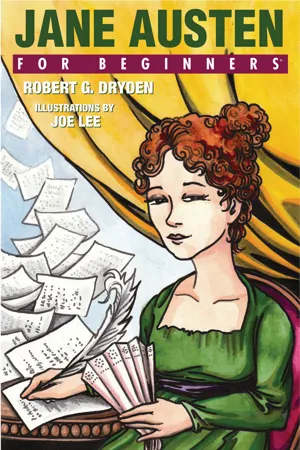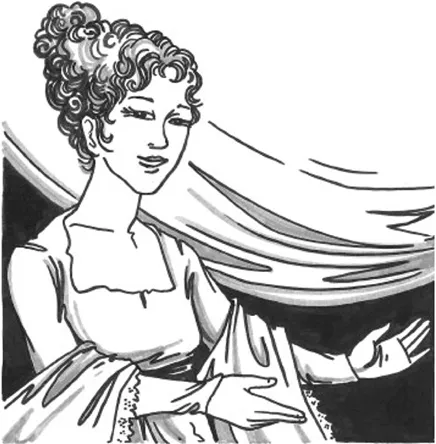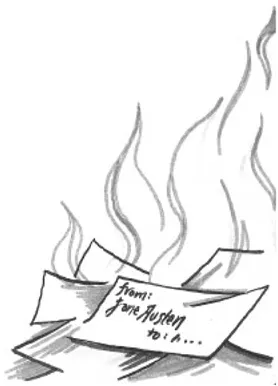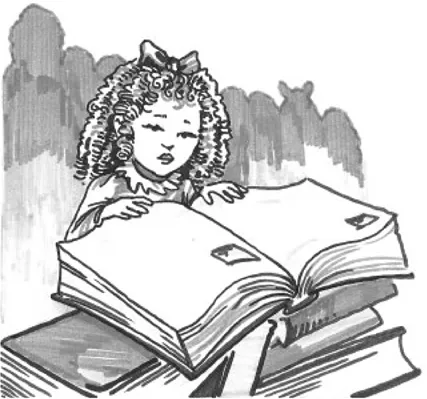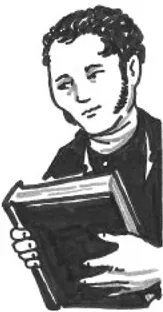![]()
Chapter 1
Introduction
Jane Austen’s impact on late twentieth and early twenty-first-century American, British, and even global audiences is so immense that it’s hard to fathom. Austenmania has become an industry, and Austen’s popularity today is arguably eclipsed only by interest in the Bard himself, William Shakespeare. With our contemporary knowledge of what a phenomenon Jane Austen has turned out to be, we should find it surprising (to say the least) that at the time of her death, her own brothers and sister initially suppressed Jane’s identity as author. When she passed away in the town of Winchester, England in 1817, and her body was carried over from 8 College Street to the spot that had been reserved for her in the mighty Winchester Cathedral, her epitaph did not mention that Jane Austen was a writer. It mentions the “extraordinary endowments of her mind” and the “sweetness of her temper,” but nowhere in the brief three paragraphs is there even a reference to the fact that this woman completed six novels and that at the time of her death she had published four of them. In fact, Jane Austen died in relative obscurity, and knowledge about the precise facts of her life remains somewhat murky. With all that is written about her today—the hundreds of texts that claim to know Jane Austen so intimately—you would think that her life had been the subject of a reality show. But that was hardly the case.
For starters we’re not sure what Jane Austen looked like. There was no family portrait commissioned, and aside from one sketch of Austen that was drawn by the amateur hand of her sister Cassandra (a second sketch by Cassandra doesn’t show Jane’s face), Jane was never the subject of an artist’s rendition. There is one recollection by her nephew James Edward Austen-Leigh, who writes fifty years after Austen’s passing in his A Memoir of Jane Austen and Other Family Recollections:
In person she was very attractive; her figure was rather tall and slender, her step light and firm, and her whole appearance expressive of health and animation. In complexion she was a clear brunette with a rich colour; she had full round cheeks, with mouth and nose small and well formed, bright hazel eyes, and brown hair forming natural curls close round her face.
Austen-Leigh’s somewhat generic description of Jane Austen is lovely, but it’s all we have. It is also imparted to us by a nephew who hadn’t seen his aunt in fifty years! Taking into consideration the great span of elapsed time, we have to accept that Austen’s precise likeness will forever remain a mystery.
Adding to the ambiguity about her personal history is the horrifying fact that Austen’s sister Cassandra (who outlived Jane by twenty-eight years) burned an estimated 2800 letters from Jane before passing away in 1845. Can you imagine how much was lost? Countless insights into Jane Austen the person—her likes and dislikes, daily activities, daydreams, fantasies, fears, troubles—are all gone forever.
• • •
And then there is the suspect biographical information we have about Austen written by those who knew her. Late in 1817, the year of Austen’s death, her brother Henry Austen penned a “Biographical Notice” as a forward to Jane’s posthumously published works, Northanger Abbey and Persuasion. In this biography, Henry begins to reinvent his sister and deify her in a likeness that people refer to as “Saint Jane.” As an example, her brother states that his sister was “Faultless … as nearly as human nature can be” and that she “sought, in the faults of others, something to excuse, to forgive or forget.” Henry paints his sister as religiously devout and incapable of behaving in any way that could be deemed negative. The love Henry shows for his sister is touching, but we can’t help seriously question the veracity of this biographical portrait. And if Jane Austen was so faultless, why would Cassandra feel compelled to burn so many of her sister’s letters?
Austen’s deification continued in 1870 with Austen-Leigh’s memoir and family recollections. Penned so long after Jane’s death, there is speculation about how much of Austen-Leigh’s loving biography is rooted securely in fact. Fifty years provides a great deal of opportunity for fiction to infiltrate the facts. This is not to say that Austen’s nephew intentionally sugar-coated his aunt’s memory, but rather that a portrait of someone created a half century later is subject to the vagaries of recollection.
My point, as I begin to provide you with some of the biographical details of Jane Austen’s life, is that there are still questions about aspects of the historical record. But that’s not necessarily a bad thing. One of the reasons for Austen’s immense popularity is that all the facts of her life are not etched in stone. There is so much room for speculation, and we Janeites (the term used for Austen groupies) like it that way.
• • •
Austen Family Background
Jane Austen was born on December 16, 1775 in a town called Steventon in Hampshire, England (sixty miles south of London) to Mr. George and Mrs. Cassandra-Leigh Austen. Jane’s father, who was orphaned by the time he was seven years old, was left no inheritance of property or money. Up until his early teens, he was cared for by an aunt on his father’s side. At age sixteen, George Austen received a fellowship that enabled him to attend St. John’s College in Oxford, and since he proved to be an excellent scholar, he stayed on to take another degree in divinity. Mr. Austen also had two successful relatives who were instrumental in helping him establish a career as a country parson: Mr. Francis Austen and Mr. Thomas Knight. By the time George Austen completed his schooling at Oxford, he received gifts of two rectories: one in the village of Steventon given to him by Mr. Knight, and the other in Deane given to him by his uncle Mr. Austen. After marrying Cassandra Leigh at St. Swithin’s Church in Bath in 1764, the couple immediately set out for Hampshire. They initially lived at the parsonage in Deane, but after four years moved over to the rectory at Steventon. They would never be rich, but they enjoyed a respectable social rank at the lower level of the gentry. In his memoir, J. E. Austen-Leigh recalls that George Austen was a handsome and charismatic man, and Jane’s mother had an acute intellect and excelled at both writing and conversation. George Austen took up the occupations of pastor and teacher for the two small communities in Hampshire and the couple commenced production of a large family. George Austen received a modest living from his work and stuck with it until he retired at the age of 70. The church at Steventon where George Austen preached and where the Austen family worshiped still stands to this day, but the rectory where they lived was torn down shortly after Jane’s death. All that remains on the property of the former Austen home is a metal water-pump handle that replaced the wooden one used by the Austen family.
As for brothers and sisters, Jane Austen had many—six brothers and one sister. Her eldest sibling was James, a man of letters who was ten years older than Jane. He and Mr. Austen provided young Jane with a strong educational background uncommon for a woman of her day. Like his father, James Austen was bound for a career in the clergy. He served as a curate in Hampshire for much of his career, and eventually moved his family into the Steventon rectory and took over as parson when his father retired in 1801.
The next eldest brother was George. He was omitted from most contemporary Austen family trees because he was developmentally disabled. He never learned to speak and was kept apart from the family for the majority of his life. It is believed that he may have been “deaf and dumb.” Mrs. Austen had a brother who was also mentally disabled, and these two men resided together as boarders with caretakers in a nearby Hampshire town.
After George, there was Edward, who was adopted at an early age in 1783 by Mr. and Mrs. Thomas Knight of Godmersham, Kent. Practically unthinkable today, the Austens relinquished parental control of one of their children in an exchange that was beneficial for both families. The Knights had all the land, money, and prestige that could ever be wanted by an elite family of the English gentry; however, they were lacking a male heir. Through the process of adopting Edward, the Knights’ line of succession was extended, and the Austens undoubtedly benefited from their now much closer connection to the Knight family. Later in his life, Edward Knight would inherit two large country estates: Godmersham Park and Chawton House in Hampshire. After the death of her father, Jane Austen would make her final residence at Chawton Cottage on the property of Edward’s estate.
Jane was closest with the fourth Austen brother, Henry. He spent the first part of his career as a banker, and after losing his business, he turned in his middle age to the profession of the clergy. He had many influential business connections in high English society and was able to assist Jane in locating publishers for her novels. He aided his sister in publishing four of them during her lifetime—Sense and Sensibility (1811), Pride and Prejudice (1813), Mansfield Park (1814) and Emma (1815)—and then in the months after Jane Austen’s death, Henry penned the biography of his sister and added it to the publication of a two-novel volume that included Northanger Abbey (completed by 1799) and Persuasion (December 1817, but dated 1818).
Next in terms of male siblings were Austen’s two sailor brothers. The first was Francis, who served in the Royal British Navy, and during his long career he climbed to the position of Senior Admiral of the Fleet. After Frank came the last Austen son, Charles, who also had a career in the Royal Navy, although not as distinguished as Frank’s. These brothers were at sea for most of their lives, but Jane maintained close contact with them through their written correspondence. Both Austen brothers were significant players in Admiral Nelson’s fleet and served in the Royal Navy during heroic Napoleonic War battles. Austen invents detailed naval characters in two of her novels, Mansfield Park and Persuasion. Her depictions of these characters are highly accurate. Austen knew her way around the details of life in the Royal Navy, more so than most women of her day could be expected. Austen’s detailed knowledge undoubtedly was accumulated through the intimate family connections she had with her sailor brothers. As Austen-Leigh notes, “with ships and sailors [Jane] felt herself at home, or at least could always trust to a brotherly critic to keep her right.”
Sister Cassandra and Jane Austen’s Letters
Cassandra Austen was Jane’s closest friend in life. She was three years older than Jane, but the two women were joined ...
